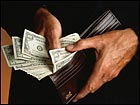|
Consumer sentiment index falls
|
 |
February 15, 2002: 9:53 a.m. ET
Wholesale price index up 0.1% but core prices fall as inflation stays in check.
|
NEW YORK (CNN/Money) - The closely watched University of Michigan consumer sentiment index dropped in early February, according to a published report Friday, with the pillar of the world's largest economy possibly showing the strain of a recession and lingering uncertainty about the future.
The sentiment index, which comes in a report available only to paying subscribers, fell to 90.9 in February's preliminary reading, compared with 93.0 in January, according to a Reuters report. Economists surveyed by Briefing.com expected an index reading of 94.0.
The current conditions index, which measures Americans' attitudes about their present financial situation, rose to 97.2 from 95.7 in January, Reuters said. But the expectations index, measuring hopes for the coming year, fell to 86.8 from 91.3 in January.
While U.S. markets reacted dramatically to the data, with stock prices falling and Treasury bond prices rising, many economists yawned.
|  | |
 |
 |
 |
| |
 CNNfn's Kathleen Hays takes a closer look at the consumer sentiment index.
CNNfn's Kathleen Hays takes a closer look at the consumer sentiment index.
| |
 |
"I'm more interested in how people spend than how they respond to surveys," said Mickey Levy, chief economist at Bank of America. "I've found that the consumer sentiment survey really doesn't provide much value added in forecasting consumer spending patterns. I'm not too upset about the decline."
Separately, the Producer Price Index - a measure of prices paid to factories, farmers and other producers - rose 0.1 percent after falling 0.6 percent in December, the Labor Department said. Economists surveyed by Briefing.com expected prices to rise 0.2 percent.
Excluding often volatile food and energy prices, the "core" PPI fell 0.1 percent after being unchanged in December. Economists surveyed by Briefing.com expected core prices to rise 0.1 percent.
"The core is up 0.3 percent over the last year, and so there really is no inflation," said Merrill Lynch economist Gerald Cohen. "In the first year of recoveries, consumer price inflation tends to fall as it did in the past 40 years. We believe inflation should not be an issue for the foreseeable future."
Between January 2001 and January 2002, producer prices fell 2.6 percent, the biggest 12-month drop since a 2.9-percent decline between February 1949 and February 1950.
Separately, the Federal Reserve said industrial production fell 0.1 percent in January after falling 0.3 percent in December. Economists surveyed by Briefing.com expected industrial production to fall 0.2 percent.
And the Fed said factories used just 74.2 percent of their capacity in January, the lowest level since April 1983 and a slight decline from December's level of 74.4 percent. Economists surveyed by Briefing.com expected capacity utilization to come in at 74.3 percent.
Click here for CNN/Money's economic calendar
To fight a recession that possibly began in March 2001, the Federal Reserve cut its target for short-term interest rates 11 times in 2001, supporting consumer spending, which fuels two-thirds of the U.S. economy. But some economists have worried that a combination of rising unemployment and debt and a shaky stock market would keep spending from bouncing back when the economy recovered.
At first glance, Friday's Michigan sentiment reading seemed to indicate those fears were justified, but many economists were willing to consider it an anomaly in otherwise positive data about consumer behavior, including gains in another closely watched confidence survey by the Conference Board.
"[Michigan's] sample size is smaller, so it's more volatile than Conference Board numbers," said Sung Won Sohn, chief economist at Wells Fargo & Co. "I would view this more as a period of digesting all the spending they've done rather than a really significant setback in consumer spending."
While keeping interest rates low to keep consumers and stock markets happy, the Fed also has to make sure it doesn't pump too much money into the economy and fuel inflation.
The Fed cut rates 11 times in 2001 to fight a recession, but inflation has not yet become an issue, with a sluggish economy keeping prices low. Some economists think the Fed will begin to raise rates later this year to fight inflation, but a weak economic recovery could delay any rate hikes.
"If the [Fed] wishes to wait an extra meeting before it raises rates, the inflation data currently give the members free hand to do so," said Joel Naroff, president and chief economist of Naroff Investment Advisors.
Click here for more on the Fed and rates
The Labor Department said overall energy prices rose 0.1 percent in January after falling 3.9 percent in December. Leading the gain were liquefied petroleum gas such as propane, up 9 percent, gasoline prices, up 3.4 percent, and heating oil prices, up 4.9 percent.
The drop in industrial production is the latest indication of the long-term suffering of the manufacturing sector. It has been in recession for more than a year, due mostly to a drastic slowdown in business spending following a spending bubble in the late 1990s.
Once the bubble burst, companies found themselves with lots of factory improvements and the ability to produce more goods, but nobody wanted to buy the goods they made.
As a result, companies are still trying to get rid of their unsold inventories before ramping up production again, and it will be a long time before they go so far as to spend for more factory improvements.
"Because investment is expected to remain weak, capacity is projected to expand only 1.0 percent in 2002, the slowest rate of increase for this statistic since it began in 1967," the Fed said. 
|
|
|
|
|
|

|

